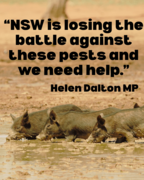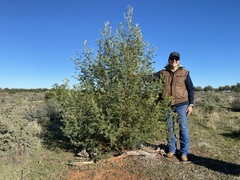From Balranald to the Deep: An Octopus Named for a Riverland Hero
Kimberly Grabham
10 June 2025, 11:00 PM

Deep in the southern ocean, a newly discovered species of octopus now bears the name of a woman from the small Riverina town of Balranald. Cirroteuthis kirrilyae, a ghostly-looking deep-sea creature, has been named in honour of Dr Kirrily Moore, a marine biologist whose career has quietly shaped our understanding of life beneath the waves.
It’s a pretty special nod for someone who grew up a long way from the coast. Balranald, sitting on the banks of the Murrumbidgee in south-west NSW, is about as inland as it gets. But Kirrily Moore’s journey from river country to the ocean’s depths shows where a curious mind and a love of nature can take you.
These days, Moore is the Invertebrate Zoology Collections Manager at the Tasmanian Museum and Art Gallery (TMAG). She looks after close to 300,000 preserved marine specimens—everything from sea jellies and anemones to strange deep-sea creatures most of us have never heard of. It’s detailed, often unglamorous work, but it’s absolutely vital for understanding Australia’s marine biodiversity.
That brings us to the octopus. Cirroteuthis kirrilyae is part of a group known as cirrate octopuses, or more affectionately, dumbo octopuses—named for the little fins on the sides of their heads that flap like ears. For years, these southern specimens were mistaken for their Arctic relatives, but in 2025, researchers Dr Tristan Verhoeff and Dr Steve O’Shea confirmed what many suspected: Australia’s version was something different. A species all of its own.
That might not sound like front-page news, but it’s a big deal in the world of taxonomy. It means that what scientists thought was one widely spread species is actually two, each adapted to its part of the world. And this one—well, it’s ours.
Cirroteuthis kirrilyae is brilliantly adapted to life in the deep. It has a flexible internal shell that gives its big fins the support they need, and its long arms are joined by thin, webbed membranes that help it drift and glide through the water. It looks almost like it's flying. Down there in the dark, where sunlight doesn’t reach and the pressure’s intense, this little octopus hunts crustaceans and worms with quiet efficiency.
The naming of the species is more than just a nice gesture. It reflects the huge amount of behind-the-scenes work done by scientists like Moore, who spend years cataloguing, preserving and analysing specimens. Taxonomy isn’t flashy, but it’s foundational. Without it, we wouldn’t even know how much life is out there, let alone how to protect it.
Describing a new species takes patience and an eye for detail. You’ve got to compare specimens, check old records, and sometimes even dive into genetic data. It’s detective work, really—and Moore has been doing it for years. Her contributions have helped build one of the most important collections of Tasmanian marine life in the world.
Having a species named after her is a well-deserved recognition, not just of her individual efforts but of the whole field of museum science. These collections act like time capsules, helping us understand changes in biodiversity, track species movements, and make discoveries like this one possible.
And there’s something fitting about it too—a deep-sea species named after someone from the heart of inland Australia. It’s a reminder that you don’t have to grow up near the ocean to make a big impact on marine science. All you need is a healthy dose of curiosity and a willingness to follow it wherever it leads.
So somewhere out there, beneath the cold, dark waves, Cirroteuthis kirrilyae is floating through the deep. It’s a quiet, graceful creature. And now, thanks to a woman from Balranald who never stopped asking questions, we know its name.
NEWS
SPORT





